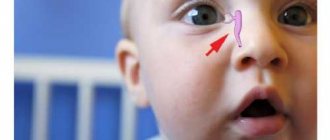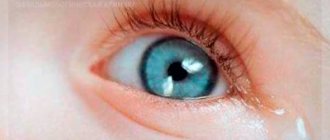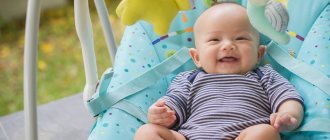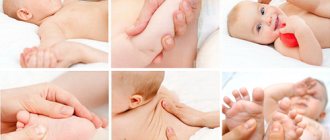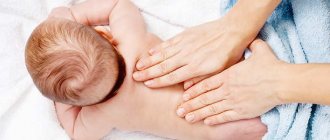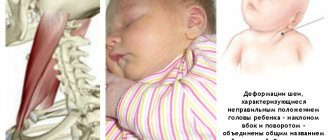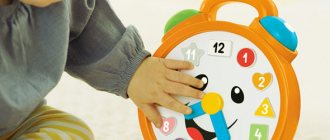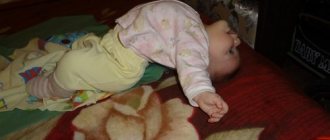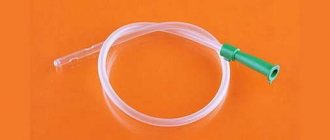Massage of the lacrimal canal in newborns is a conservative treatment method that eliminates blockage of the canal itself. To keep a newborn's eyes healthy, the normal functioning of the tear ducts is important. If they are clogged, then tears cannot flow out of the eyes, the lacrimal sac fills with liquid, swelling is observed, an inflammatory process develops, and infection occurs.
To eliminate these unpleasant symptoms, massage the lacrimal canal.
Diagnostics
It can be quite difficult for parents to independently examine the child, since the baby may desperately resist attempts to put pressure on the inflamed lacrimal sac.
However, not every mother will risk doing this on her own. Therefore, the ophthalmologist always begins the examination with palpation of the lacrimal sac and determining the nature of the discharge. To confirm the diagnosis, a special technique is used, which is called the “Vest tubular test”. The nasal passage on the side of the affected eye is tightly closed with a cotton swab, and a contrast agent (collargol solution) is instilled into the eye.
If the tubule is patent, within a minute or two traces of a dye will appear on the cotton swab. In case of obstruction, the cotton wool remains clean. In case of obstructed circulation, which occurs when the lacrimal duct narrows, traces of collargol on the tampon appear with a great delay. That is why the West test is evaluated not only after 2-3 minutes, but also after 15 minutes, if there were no traces of dye on the tampon the first time.
To determine the extent of the blockage or narrowing, doctors may perform diagnostic probing. During the procedure, the tear duct will be irrigated. If the liquid flows only from the eye and does not enter the nose, doctors will be able to determine at what level the obstruction has arisen.
To do this, smears of the contents that are released during palpation are sent to a bacteriological laboratory for analysis. This allows you to establish the exact name of the pathogen and prescribe adequate and effective treatment.
In difficult cases, other specialists are also invited for treatment - an ENT specialist, a surgeon, a facial surgeon, a neurosurgeon and a neurologist.
In newborns and infants, diagnostic procedures are usually carried out according to a simplified procedure - an examination by an ophthalmologist and an analysis of bacterial culture of the contents of the lacrimal sac are sufficient.
What to do first if it is closed
If you notice the above symptoms, you should visit an ophthalmologist. You should not put drops or gels into your eyes, especially those containing antimicrobial substances; they can blur the clinical picture.
You should not wash your baby’s eyes with tea leaves or herbal infusions if the tear ducts are needed. This can only temporarily eliminate the signs of pathology, but not get rid of it completely.
Once you stop rinsing your eyes, the symptoms of the disease will return and it will progress. The main cause of the disease - blockage of the tear ducts - will not be eliminated.
Sodium sulfacyl should not be instilled into the eyes: crystals formed when using the medication can only aggravate the pathological process.
To make a diagnosis, an ophthalmologist may prescribe the Vesta test. It is carried out as follows: a solution of collargol is instilled into the eyes, and a cotton wick is inserted into the nasal cavity; if the turunda becomes colored, the diagnosis is not confirmed.
If after 15 minutes no staining has occurred, then the nasolacrimal duct is closed, which indicates dacryocystitis.
Sometimes your doctor may order an x-ray of the nasolacrimal ducts using a contrast agent.
If the disease is not advanced, the doctor prescribes a massage of the lacrimal canal. Conservative therapy is effective until the child is 2 months old. It is worth remembering that the older the baby, the more painful the massage of the lacrimal canal will be.
Features and techniques of massage
Symptoms of blocked tear ducts are often caused by a pathological condition called dacryocystitis. This disease is widespread among newborns. Daily massage of the baby's eyes helps to cope with it as soon as possible. The therapeutic massage technique is available to every young mother interested in this issue.
Before starting a massage, do not forget to take care of hygiene rules. Massage must be performed under sterile conditions. Mom's fingernails need to be trimmed. After this, wash your hands thoroughly and use sterile latex gloves.
When performing massage movements, it is important to avoid the use of brute force and sudden movements.
The massage technique itself looks like this:
Before starting massage movements, it is necessary to identify the newborn's lacrimal sac in the inner corner of the eye. Recognizing this anatomical formation is not difficult. It can be easily felt with the index finger, which is placed in the direction from the outer corner of the eye to the inner one; The next stage of the therapeutic massage is gentle pressure with the pads of the index fingers on the area of the lacrimal tubercle
In this matter, you must be careful not to resort to sudden movements; If there is purulent discharge from the lacrimal canal in a newborn child, massaging movements are carried out using sterile napkins or cotton wool, with the help of which the baby’s eyes are cleaned; After cleansing the lacrimal sacs, the child’s eyes should be washed with chamomile decoction or a weak solution of Furacilin; Carrying out massaging movements in the area of the lacrimal canal, move towards the superciliary arches; Next, massage with smooth movements in the direction from the inner corner of the eyes to the tip of the baby’s nose. This manipulation not only has a beneficial effect on the nasolacrimal duct, but also contributes to the rupture of the so-called embryonic film.
After completing this procedure, the baby is instilled with 2-3 drops of Vitabact or Levomycetin in each eye. If necessary, the massage procedure is performed up to 4-5 times a day. The duration of treatment is at least 14 days. If necessary, the period is extended to 21 days.
An important point in achieving a positive result is not only the smoothness of movements, but also their jerkiness. This type of movement helps to uniformly cleanse the lacrimal sacs from purulent and mucous contents. The frequency of repetitions of massage movements is at least 15 times. When diagnosing dacryocystitis in newborns, therapeutic massage acts as an effective and safe method of correcting this condition.
The technique itself does not cause difficulties for most young parents, but we must not forget about safety measures. In order not to harm the newborn baby, this event is carried out in accordance with generally accepted instructions.
If questions arise regarding therapeutic massage techniques, parents can seek advice from a medical specialist who will demonstrate the gold standard for therapeutic eye massage for newborns. If these recommendations are followed, parents will be able to observe a positive result after 2-3 therapeutic massage procedures.
Subscribe to our VKontakte group
Features of pathology in children
Tears are of great importance for eye health.
Tears are an important physiological fluid that bathes the eyeball. They moisturize the surface of the eye and contain antibacterial substances. Tear fluid is constantly produced.
At the inner corner of the eye, tears accumulate and flow into the nasal cavity through the lacrimal canals. During fetal development these tubules are closed.
But by the time the baby is born, the films inside the tear duct break through, and the tear fluid is removed from the eye system in a natural way.
In rare cases, the film does not rupture. The tear is not removed from the eye system and accumulates in the conjunctival sac. At the same time, it becomes contaminated with dust particles and bacteria and an inflammatory process develops.
In the initial stages of the disease, parents try to fight the disease on their own. Antibacterial drops are used and washed with decoctions of medicinal herbs.
The treatment helps, and the inflammatory process subsides for a short time. But when antibacterial agents are discontinued, suppuration resumes, since the cause of the disease - stenosis of the lacrimal canal - has not been eliminated. Pathogenic flora enters the palpebral fissure and begins a new round of the inflammatory process.
The role of the procedure in the treatment of dacryocystitis
All therapeutic measures for dacryocystitis, including massage, involve restoration of the nasolacrimal duct, which is clogged, elimination of the inflammatory process in the lacrimal sac and sanitization of the lacrimal system.
The stimulating effect on the lacrimal sac promotes the rapid breakthrough of the “plug”, as well as the normalization of oxygen metabolism.
Local effect on the skin around the eyes when the lacrimal gland is blocked stimulates blood circulation and regulates water-electrolyte metabolism, relieves swelling and stimulates lymph flow. Also, there are nerve plexuses nearby, the massage of which has a positive effect on the central nervous system, calming it and providing the proper restorative effect.
Observations show that correct and regular massage of the lacrimal canal leads to complete recovery in 25% of children under 3 months of age. After the massage procedure, the conjunctival cavity is washed with antiseptics (furacilin) or a decoction of herbs using antibacterial drops (picloxidine, moxifloxacin, tobramycin, chloramphenicol, gentamicin).
For this disease, the doctor may prescribe UHF, general antibiotic therapy. By following all these measures, you significantly increase the chances of your baby’s recovery.
ATTENTION! If there is no result from massage and conservative measures within a week, the lacrimal ducts are probed, during which a mechanical rupture of the embryonic plug occurs.
Immediately after probing, the nasolacrimal canal is washed. For infant dacryocystitis, which is caused by obstruction of the lacrimal canal with an embryonic film or plug, probing is highly effective in 95% of cases. To completely eliminate the inflammatory process and eliminate the chance of recurrence of dacryocystitis in infants, treatment with medications and repeated rinsing is carried out for 2 months.
Combining massage with other therapies
In addition to massage of the lacrimal canal to treat dacryocystitis, the doctor prescribes antibacterial eye drops to reduce the risk of a secondary infection.
An antibiotic is selected based on the sensitivity of the pathogen to it.
The following medications are allowed to be used in pediatrics:
- Tobradex eye drops 3%;
- chloramphenicol eye drops 0.25%, they can be used in children older than 4 weeks.
If the doctor prescribed several eye drops at the same time, then they should be instilled at intervals of 20 minutes.
To make the massage more effective, after consultation with a specialist and in the absence of individual intolerance, it is permissible to use traditional medicine recipes:
- Place 2 drops of Kalanchoe juice into each eye. Frequency: 3 times a day.
- Make compresses for the eyes with infusion of chamomile and dill.
- Apply brewed and cooled tea bags to the baby's eyes.
You need to understand that traditional medicine recipes can only be used as additional means. It should be remembered that self-medication with them is unacceptable, as they have their own contraindications.
Precautionary measures
The most important thing is not to harm the baby during massage. This can be done by following the appropriate rules:
- Before starting massage procedures, you should consult with a pediatric ophthalmologist and get diagnosed with him. Before performing a massage without the help of a professional massage therapist, ideally you need to watch how a specialist does it.
- Before each manipulation of the child’s face, all necessary hygiene procedures must be carried out.
- Along with massage actions, it is necessary to use eye drops that were prescribed by a doctor and follow the prescribed dosage.
- If there is no result from massaging or the general condition of the baby worsens, you should immediately consult a doctor. You should also contact a professional massage therapist if signs of membrane tissue elimination appear. This is required to confirm the elimination of the disease and to receive advice on caring for the child and his speedy recovery.
Additional Information
Treating dacryocystitis with massage seems like a simple procedure. But it has a number of features. What to pay attention to:
- An ophthalmologist should teach parents how to use the procedure. Not to tell, but to show! Mom's finger!
- All manipulations should be carried out persistently, but without force. The baby's nose and eyelids are a delicate area and can easily be damaged by careless movements.
- During the massage, the child may cry. This will increase the effectiveness of the procedure, as additional pressure is created. This increases the likelihood of rupture of films in the tear duct.
- Make sure that purulent masses do not get into the ear or healthy eye.
- The eye is located in close proximity to the brain. If treatment is not done in a timely manner, infection of neighboring organs occurs.
- If conservative treatment is ineffective, it is necessary to bougienage the lacrimal canal.
- If therapy with antibacterial drops is indicated, then carry out the procedures as prescribed by the ophthalmologist.
Treatment of dacryocystitis in infants and adults
Treatment of dacryocystitis in adults begins from the moment of diagnosis
It is important to properly massage for dacryocystitis in adults for 10-15 days. Additionally, installations of solutions are used: 20% solution of Albucid (sulfacyl sodium), 2% solution of collargol
If the effect is insufficient, then the lacrimal duct and sac are washed under pressure with disinfectant solutions or lacrimal duct antibiotics.
Then the lacrimal ducts are probed with solutions of lidase, fibrinolysin, and trypsin introduced into them. This slows down the process of scarring of the canal. In some cases, rough adhesions must be removed surgically.
Drops for dacryocystitis are prescribed in case of bacterial infection, when pus is released during massage. Antibacterial ointments are not used for dacryocystitis, since they can clog the lacrimal openings due to their dense structure.
Antibacterial eye drops for acute or chronic dacryocystitis in adults:
- Tobrex (tobramycin);
- Tsiprolet, Tsipromed for eyes (ciproflaxacin);
- Floxal ointment for blepharitis, Ofloxacin ointment (ofloxacin);
- Signicef (levofloxacin);
- Levomycetin (chloramphenicol);
- Vitabact (picloxidine);
- Sulfacyl sodium (sulfacetamide);
- Maxitrol (neomycin + polymyxin B + dexamethasone).
Safe rules for lacrimal sac massage in children and adults
It is important to massage the lacrimal sac in newborns with clean hands. This is the only home treatment option for dacryocystitis in a newborn.
The lacrimal sac is located in the inner corner of the eye; you can feel it yourself, then place your finger in the same place for the child and lift it 0.5 cm so that it is fixed above the lacrimal sac.
Using light pressing movements, massage from top to bottom. During one trip, you need to make 10-15 such movements, and then collect the discharge from the lacrimal sac and wipe the area with furatsilin solution. You can supplement the massage for dacryocystitis with movements from the bridge of the nose to the corner of the eye.
Cut your nails before the procedure to avoid damaging your child's skin.
Treatment of dacryocystitis in newborns is carried out within 10 days. If massage does not help with dacryocystitis, you need to move on to the probing stage.
To learn how Komarovsky proposes to treat dacryocystitis in newborns, watch the official video. It shows how a doctor performs a massage for dacryocystitis.
Probing for dacryocystitis
Probing for dacryocystitis in newborns is performed if there are congenital adhesions in the canal, as well as if massage courses are ineffective for 10-15 days.
This is a minimally invasive intervention, which is carried out by introducing a special thin probe into the lacrimal opening and removing it through the nasolacrimal duct to the nasal cavity. If the child is under 1 year old, then probing is performed under local anesthesia. Anesthetics are dripped into the eye, but the children still cry from fear. Children over 1 year of age undergo the procedure under anesthesia or medicated sleep, so it is better not to delay the probing. The procedure itself lasts 10-15 minutes.
The effect of probing for dacryocytitis appears after 3-5 days. The first days after the intervention there may be a slight discharge of pus and traces of tears. For 5 days after the procedure, it is necessary to drip antibacterial drugs into the eye 2 times a day.
If the child has a narrow canal from birth and there are adhesions, then carry out the probing procedure again after 2-3 months. To repeat the procedure, a larger probe is taken and enzymes are introduced into the canal along with it to prevent scarring. There is a high probability that the narrow canal will expand on its own as the child grows. For the period from birth to one year, silicone capillaries can be placed to improve the outflow of tears.
Video of probing for dacryocystitis in newborns.
When do you need an eye massage?
During intrauterine life, the lacrimal canals are closed by an embryonic membrane, preventing the penetration of amniotic fluid into them. After birth, with the first cry and breath, the film breaks and the nasolacrimal ducts begin to function correctly, but sometimes this is not observed.
Normally, tears can escape from a newborn's eyes without problems.
Tear fluid performs a number of functions:
- protects the organs of vision from aggressive environmental factors, and the cornea and connective membrane from drying out;
- washes out and destroys germs;
- Thanks to the thinnest film formed, correct refraction of light rays is possible, and, consequently, good clarity of vision.
The lacrimal gland normally constantly produces a small amount of tear fluid, which envelops the cornea in a thin layer.
If the opening of the lacrimal duct in a baby is closed with a membrane, the tears do not flow into the nasal cavity, but accumulate in the outer corner of the eyes and from time to time flow over the lower eyelid.
This condition is called tear duct obstruction. And if it is observed in children 14-21 days old, then this is a variant of the norm.
After this time, the membrane should spontaneously resolve. If this does not happen, then tears accumulate in the lacrimal sac and inflammation develops - dacryocystitis.
An eye massage for the tear duct can help break down the sealed water-repellent membrane.
Techniques and Techniques
The main cause of blockage is increased pressure on the tear duct and swelling. The pediatrician prescribes the procedure. In the hospital, parents are shown how to properly massage the eyes of a newborn and are told about the structural features of the skull
It is important to take into account that in children the bone tissue has not yet been formed, instead there is cartilage, which is very easy to damage if massage movements are performed incorrectly. The optimal age of a child for conservative treatment is 3-4.5 months
The older the child gets, the greater the risk of complications.
Preparation for massage: sterile wipes, disinfectant solution, Vaseline
The main condition for the procedure is sterility.
Cut your nails to the roots and wash your hands with bactericidal soap before starting the session. Wear sterile gloves. You need to prepare a solution of furatsilin: 1 tablet per 100 g of boiling water. Cool it to 36.6.
Place the toddler on a flat, hard surface. In rare cases, procedures may be performed during feeding. The child should feel comfortable. To begin with, you can perform a soothing massage of the entire body, and then move on to the facial part.
The procedure begins with squeezing out the mucus from the newborn's eye. Use the pad of your index finger to feel the bulge in the corner of your eye. Place the phalanx of the finger in the direction from the outer edge to the corner, lightly press on the tubercle. Remove the pus with a cotton swab. Drop a few drops of furatsilin. Jerking and vibrating movements are performed with the pads of the index or middle fingers from top to bottom along the nasolacrimal duct. The essence of the technique is to damage the epithelial film.
The massage cycle consists of 11 movements:
- 10 jerky - from top to bottom;
- 1 vibrating from bottom to top.
Instill an antiseptic drug prescribed by the doctor, usually Levomycetin, Tobrex, Vitabact, Albucid, Tsiprolet are used. Up to 5 sessions lasting up to 1 minute are performed per day.
How to find out if procedures help and when to see a doctor
As a rule, after 2 weeks of massage, the rudimentary membrane ruptures and the nasolacrimal duct opens.
The symptoms listed above may indicate that it is still clogged.
In any case, after completing the massage session, you should show the child to a specialist.
If the tear ducts are blocked, the doctor may prescribe probing. A probe is inserted into the lacrimal punctum to help expand the nasolacrimal duct.
When the probe is removed, the patency of the lacrimal ducts is normalized. After removing the instrument, the canal is treated with an antiseptic.
If the intervention is successful, the liquid pours out of the child’s nostrils or enters the nasopharynx. Sometimes the procedure will have to be carried out 2-3 times.
There is no need to be afraid of probing, although parents usually find it unpleasant to watch the process itself. The procedure is well tolerated by the baby; more dangerous are the complications that can develop if dacryocystitis is not eliminated.
Probing should be carried out when the child is 2-6 months old. The procedure is carried out using light mask anesthesia.
Medicines will not harm the child and will not negatively affect further development, but will allow the pediatric ophthalmologist to perform high-quality probing.
The baby, being in a state of medicated sleep, will not be able to interfere with the doctor, which will reduce the likelihood of complications from the procedure and avoid repeated bougienage.
After the procedure, a course of massage and medications are prescribed to reduce the likelihood of adhesive disease.
The main benefits of massage
Since inflammation of the lacrimal sac is diagnosed mainly in newborns, it is worth considering not drug therapy, but gentle procedures.
If you don’t want to “poison” your baby with antibiotics and antiseptics, then you can learn how to give him a massage. So, what are its benefits:
But how massage is done for obstruction of the lacrimal canal in newborns, and how to do it correctly, is indicated here.
On video - massage for dacryocystitis in newborns:
The massage will not cause pain to the child, it will cause slight discomfort. The procedures will have to be carried out several times a day.
Here's how to massage the eyelids for blepharitis, and what conditions must be met for the correct procedure. This video will help you understand.
A mother may notice the first signs of the disease while she is with her baby in the maternity hospital. In this case, the children's nurse will teach you how to properly care for the baby and give massage. If the disease was diagnosed later, you can learn how to massage your child yourself.
Principles of the procedure
Before the disease leads to complications, it is worth learning all the intricacies of lacrimal sac massage:
The child must be placed on a changing table or a specially prepared surface. So that the baby's head is on a flat, smooth surface directly in front of the mother's face. Afterwards, a special drug is instilled into the baby’s eye; it can be saline solution or any other medication prescribed by an ophthalmologist.
The child's eyelid is closed and drawn along it from the back corner to the bridge of the nose. This will help moisturize the mucous membrane and remove impurities. Then you should go directly to the massage of the lacrimal sac, it is located just below the eyeball, near the bridge of the nose. During the procedure, pus will begin to come out of the bag; it should be removed with a cotton swab or sterile napkin.
The procedure lasts several minutes, and the baby may cry, there is nothing wrong with that
Increased lacrimation will remove any remaining pus from the sac. When the discharge stops, it is worth rinsing the child’s eye several more times with saline solution or Furacilin. It is important not to touch the mucous membrane and not to apply additional pressure during the massage.
Massage begins after all the pus has been removed from the child’s eye. Touch the lacrimal sac about 6-10 times with slight pressure
Moving from the inner corner of the eye to the bridge of the nose.
Discharge is removed using a cotton swab soaked in Furacilin solution. The drug will help reduce inflammation and get rid of the disease faster.
It is also worth paying attention to this. How does eyeball massage occur during destruction of the vitreous?
The video shows how the procedure is carried out:
Light, circular movements of your finger will help tear the film faster. Assessing the symptoms will help you understand that this has happened:
- when pressing on the lacrimal sac, the discharge of pus stopped;
- tears flow from both eyes;
- nothing bothers the child anymore.
You can contact an ophthalmologist, he will help you understand the situation and accurately determine whether the film has broken.
How to massage if the tear duct is obstructed?
After completing the preparatory activities, you can begin the massage. Manual manipulations must be performed correctly. The idea is to carefully squeeze out the fluid accumulated in the lacrimal sac. The massage is performed in the direction from the corner of the top of the eye downwards. Massage of the nasolacrimal passage is simple and can be done at home.
Algorithm of actions:
- Place the fingertip just above the inner corner of the eye;
- feel the lacrimal sac;
- perform sliding movements from the lacrimal canal to the wing of the nose, applying moderate pressure at this time;
- make jerking movements about 10 times;
- perform vibrating movements in the direction from bottom to top.
If purulent fluid comes out, then you need to drip a solution of furatsilin at room temperature into the eye. Then use a clean cotton swab to remove the discharge. If there is no furatsilin, then you can use Levomycetin or Vitabact.
With dacryocystitis, it is better to start doing massage at the moment when the child is crying. At this time, the tear ducts are tense. Therefore, the procedure will be more effective.
Uninstall in Safe Mode
If none of the listed methods allows you to completely remove Doctor Web antivirus from your computer, then the last option remains - uninstalling the program in Windows safe mode. Launching safe mode allows you to unload the system and start it in a debugging state. Removing such serious programs as antivirus in safe mode allows you to avoid errors and failures. So, if you encounter problems using the previously described methods, then remove the antivirus by launching Windows Safe Mode. To do this, you need to restart the computer and, during system startup, constantly press the F8 key until the selection of the operating mode is displayed on the screen. Afterwards, all you have to do is uninstall the program in the standard way through the Control Panel.
Why is it needed?
Dacryocystitis is a common disease in which blockage and inflammation of the tear drainage system occurs. The tears produced by the glands cannot drain normally through the nasal cavity. As a result, blockage and stenosis of the nasolacrimal duct occurs, which, if not addressed in a timely manner, leads to dangerous complications.
Typical symptoms of tear duct obstruction are:
- stagnation of tears;
- swelling, inflammation of the conjunctiva in a clogged eye;
- redness of the whites;
- if there is a bacterial infection inside the gland, the release of purulent exudate as with conjunctivitis.
All these symptoms are indications for massage in infants. For dacryocystitis in newborns, complex therapy is prescribed, and a special eye massage for obstruction is necessarily included in its scheme. The procedure is carried out by a specialist; if the mother wants to master the technique, it is important to learn all the subtleties and aspects of massage, otherwise the opening of the tubule will not be achieved.
Advice from Dr. Komarovsky
Dr. Komarovsky advises parents not to self-medicate. Only a doctor prescribes ointments or drops with antibiotics for sore eyes. Moreover, before selecting a medicine, a bacterial culture is carried out, the task of which is to find out which pathogen led to the development of the disease. The frequency of drug administration is also determined by the attending physician.
Drops after massage, according to Komarovsky, do not need to be instilled after each massage procedure. After all, there are 7 or even 8 of them per day. Such frequent application of drops or ointment is impractical.
It happens that parents do not fully understand the technique of the procedure. In this case, there is no need to try to carry out the procedure at any cost. It is better for a young mother to go to a children's clinic, where they will show her how best to massage the lacrimal canal.
When there is no pronounced purulent process, a warm compress is applied before the massage. The effect of this will be much better.
Treatment tactics
Treatment depends on the age of the child. They start with conservative therapy. It includes the use of antibacterial and hormonal drops 3-4 times a day, washing the eyes with decoctions of medicinal herbs and massage of the lacrimal canal.
All procedures are carried out at home, hospitalization is not indicated. In most cases this is enough. The films blocking the lacrimal canal are torn, patency is restored and the inflammatory process subsides.
In some cases, conservative therapy is not effective. Therefore, the doctor will recommend invasive manipulation - bougienage and lavage of the lacrimal canal under local anesthesia.
The procedure is carried out upon reaching 3 months of age. At earlier stages, manipulation is not carried out, since there is a high risk of injury and relapse of the disease. At an older age, bougienage is performed under general anesthesia, since the baby is already active.
The likelihood of canal stenosis also increases. Therefore, 2.9–3.5 months is the optimal period for restoring the patency of the lacrimal canal.
Contraindications
If the baby does not feel well, the procedure is not performed.
Eye massage in a newborn is the only measure that allows you to get rid of the disease in a conservative way. However, not all children are allowed to perform the procedure. Absolute contraindications are phlegmanoma and hydrops of the lacrimal sac. Massaging is not recommended for acute infectious and inflammatory processes, accompanied by an increase in body temperature and a disturbance in general well-being.
Preparing for a massage
In order for future therapy to bring maximum results for massage, you need to prepare not only the child, but also the mother. Mom should:
- Trim your nails.
- Wash your hands thoroughly.
- If your palms are cold, then it is better to warm them up.
- The finger that will participate in the massage should be lubricated with baby cream.
Before starting the massage, you should wash your hands thoroughly.
Efficiency
Correct execution of manipulations will lead to the desired result within a couple of weeks.
If the massage for dacryocystitis is correct, after 1-2 weeks it will be possible to achieve the opening of the nasolacrimal duct, after which it will function without disturbances. The procedure helps to avoid surgical treatment, which, like any surgical intervention, can cause postoperative complications and consequences in infants.
According to Dr. Komarovsky, properly performed massage for blocked tear ducts in children under 10 months. helps to completely cure the disease without resorting to surgical methods of therapy.
